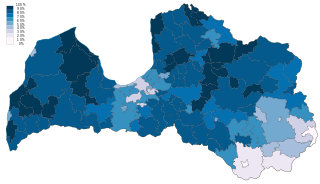
Back Алатыш бызшәа Abkhazian Lets Afrikaans ላትቪኛ Amharic Idioma letón AN Lettisc sprǣc ANG लातवियाई भाषा ANP اللغة اللاتفية Arabic لاتفى ARZ Idioma letón AST Latviava AVK
| Latvian | |
|---|---|
| Lettish[1] | |
| latviešu valoda | |
| Pronunciation | [ˈlatviɛʃu ˈvaluɔda] |
| Native to | Latvia |
| Region | Baltic |
| Ethnicity | Latvians |
Native speakers | 1.5 million[2] (2023) |
| Dialects |
|
| Latin (Latvian alphabet) Latvian Braille | |
| Official status | |
Official language in | |
| Language codes | |
| ISO 639-1 | lv |
| ISO 639-2 | lav |
| ISO 639-3 | lav – inclusive codeIndividual codes: lvs – Standard Latvian languageltg – Latgalian |
| Glottolog | latv1249 |
| Linguasphere | 54-AAB-a |
 Use of Latvian as the primary language at home in 2011 by municipalities of Latvia | |
Latvian (endonym: latviešu valoda, pronounced [ˈlatviɛʃu ˈvaluɔda]),[3] also known as Lettish,[4] is an East Baltic language belonging to the Indo-European language family and it is spoken in the Baltic region. It is the language of Latvians and the official language of Latvia as well as one of the official languages of the European Union.[5] There are about 1.5 million native Latvian speakers in Latvia and 100,000 abroad. Altogether, 2 million, or 80% of the population of Latvia, spoke Latvian in the 2000s, before the total number of inhabitants of Latvia slipped to 1.8 million in 2022.[6] Of those, around 1.16 million or 62% of Latvia's population used it as their primary language at home, though excluding the Latgale and Riga regions it is spoken as a native language in villages and towns by over 90% of the population.[7][8][9]
As a Baltic language, Latvian is most closely related to neighboring Lithuanian (as well as Old Prussian, an extinct Baltic language); however, Latvian has followed a more rapid development.[10] In addition, there is some disagreement whether Standard Latgalian and Kursenieki, which are mutually intelligible with Latvian,[11] should be considered varieties or separate languages.[12] However, in Latvian linguistics, such hypotheses have been rejected as non-scientific.[citation needed]
Latvian first appeared in print in the mid-16th century with the reproduction of the Lord's Prayer in Latvian in Sebastian Münster's Cosmographia universalis (1544), in Latin script.
- ^ "Lettish". TheFreeDictionary.com. Retrieved 28 July 2007.
- ^ Valsts valoda
- ^ Prauliņš (2012), p. 1
- ^ Prauliņš (2012), p. 1
- ^ "EU official languages". European-union.europa.eu. Retrieved 1 August 2022.
- ^ "Dažādu tautu valodu prasme". vvk.lv (in Latvian).
- ^ "At Home Latvian Is Spoken by 62% of Latvian Population; the Majority – in Vidzeme and Lubāna County". Central Statistical Bureau of Latvia. 26 September 2013. Retrieved 30 October 2014.
- ^ "Latvian Language Is Spoken by 62% of the Population". Baltic News Network. 26 September 2013. Retrieved 30 October 2014.
- ^ Žemaitis, Augustinas. "Languages". OnLatvia.com. Retrieved 1 August 2022.
- ^ Dahl, Östen; Koptjevskaja-Tamm, Maria, eds. (2001). The Circum-Baltic Languages. John Benjamins Publishing. ISBN 9027230579. OCLC 872451315.
- ^ "How Latgale chose to join Latvia". Public Broadcasting of Latvia. 2 May 2017. Retrieved 27 October 2017.
The Latgalian language falls within the High Latvian dialect and is of course mutually intelligible with the other dialects.
- ^ "Latgalian Language in Latvia: Between Politics, Linguistics and Law". International Centre for Ethnic and Linguistic Diversity. 30 March 2018. Retrieved 6 August 2018.